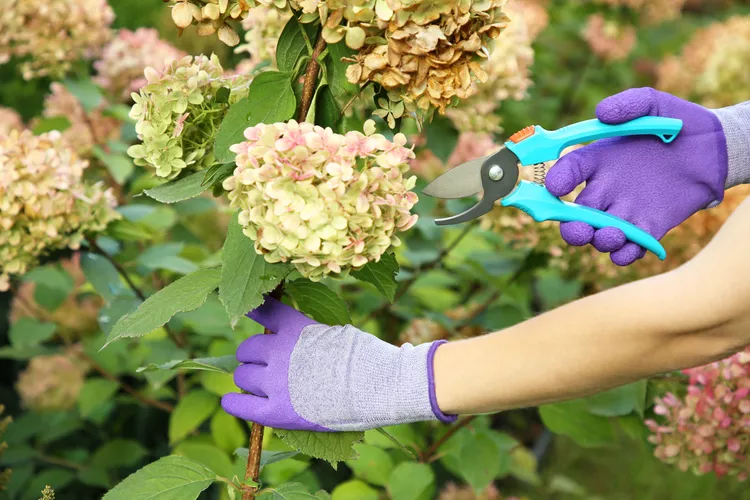Hydrangeas add gorgeous flowers to your garden in clusters that can last for up to two months. Once those flowers fade, is deadheading hydrangeas a good idea? Removing the spent flowers can encourage more flowering throughout the season, but it depends on the type of hydrangea and your timing. Here’s what you need to know about deadheading hydrangeas the right way, according to a hydrangea expert.
Ryan McEnaney is a garden designer and spokesperson for Endless Summer hydrangeas and First Editions plant brands.
Why Deadhead Hydrangeas?
Deadheading encourages hydrangeas to use their energy to make new flower heads instead of seeds. It stimulates new foliage and stem growth, setting up the plant for more blooms.
Deadheading can prompt a hydrangea to develop stronger stems, according to Ryan McEnaney, a garden designer and spokesperson for Endless Summer hydrangeas and First Editions plant brands. It can also make your shrub look tidier if you don’t like the look of dried flowers on your hydrangeas.
Don’t confuse deadheading with pruning. Pruning hydrangeas involves removing big sections of the plant's wood and stems. Deadheading involves just clipping off the spent flowers and as little of the stem as possible.
When to Deadhead Hydrangeas
The best time to deadhead hydrangeas depends on the type you grow. There are three general categories of hydrangeas based on how they bloom.
New Wood Hydrangeas
New wood hydrangea varieties bloom on the current year’s growth. They create their flower buds in early spring on new stems as soon as the shrub comes out of winter dormancy. New wood hydrangeas include smooth hydrangeas, panicle hydrangeas, and some bigleaf and mountain hydrangeas.
You can deadhead new wood hydrangeas during the growing season, McEnaney says, but doing so isn’t vital to plant health. It’s more of an aesthetic choice. And for some hydrangeas, the spent flowers can actually be quite attractive themselves. “I wouldn’t recommend deadheading panicle hydrangeas, especially if you live in a cooler climate, because they have beautiful fall colors.” However, if you live in a hot climate where spent hydrangea flowers turn brown and you don’t like the look of them, it's totally fine to snip them off.
If you choose to leave faded flowers on into the fall, you can deadhead new wood hydrangeas in late fall into winter all at once when they are dormant and have dropped their leaves. You need to deadhead them by late winter, though, or you run the risk of cutting off new flower buds, McEnaney adds.
Old Wood Hydrangeas
Old wood hydrangeas are varieties that bloom on last year’s stems. They create their flower buds for next year when they finish blooming this year. The flower buds sit on the plants all year, waiting until summer to bloom. Old wood hydrangeas include oakleaf hydrangeas, climbing hydrangeas, and older bigleaf and mountain hydrangeas varieties.
There’s no need to deadhead old wood hydrangeas unless you want to tidy up the plant, McEnaney says. Deadheading will not make old wood hydrangeas bloom again this season. They bloom once, and they’re done until next year. For this reason, you need to be careful when you deadhead.
“You don’t want to do any deadheading or pruning after August when they start developing flower buds for the next season,” McEnaney says. Trim too late this year, and you may cut off next year’s buds and have a bloomless summer.
Reblooming Hydrangeas
Reblooming hydrangeas bloom again in the same season because they flower on both old and new growth. These tend to be newer hydrangea varieties introduced in the last two decades since the ‘Endless Summer’ hydrangea became the world’s first hydrangea to bloom all season long. Some notable rebloomers include ‘White Wedding’, the ‘Seaside Serenade’ series, ‘Pop Star’, and the ‘Let’s Dance’ series.
Reblooming hydrangeas should be deadheaded right after they finish their spring or summer blooming cycle. You’ll get a second round of flowers if you promptly clip off the old blooms.
Leaving spent hydrangea blooms on the shrub over the winter provides a winter home for beneficial insects as well as texture and structure in the winter garden.
How to Deadhead Hydrangeas
Old wood hydrangeas don’t need to be deadheaded unless you want to tidy the plant. Cut off the flower head by snipping the stem just above the first set of large leaves, McEnaney says. “That leaf axil is where the new bud will develop. If you cut too far down, you’re messing with next year’s blooms.”
You can be more aggressive with hydrangeas that bloom on new wood. You still want to cut the stem just above a set of full-sized leaves, but you can cut as much as a third of the stem off a new wood hydrangea to encourage a bushier habit.




















